
| The Comptroller's Report |
Nancy Wyman - State Comptroller
|
Connecticut's Workers Among Most Productive in Nation
Diverse, Well-Educated Workforce Poises State for Economic Recovery
With one of the most productive and diverse workforces in the nation,
Connecticut is well positioned to resume a course of economic expansion.
According to the Connecticut Department of Labor, worker productivity in the
state is 23 percent above the national average. The state's workforce is highly
educated and well trained. Connecticut ranks third nationally in the percent of
population over age 25 who hold a bachelors degree or higher.
This robust level of productivity and advanced education results in high
wages. Connecticut ranks first in the nation in average annual pay, with an
average salary of over $45,000.
The state's industrial base with its 93,000 business establishments has
diversified over the last decade. While defense and insurance continue to be
important industries, the state's economic development is increasingly tied to
industries such as bioscience, software development, pharmaceuticals,
communications and medical technology.
A federal Department of Labor survey put the number of high-tech workers in
the state at 77,500 in 2000, up 23 percent from 1994. Connecticut ranks fifth
among all states in the percentage of workers employed in technology
occupations.
Connecticut also benefits economically from its geography, especially its
location between the financial centers of Boston and New York. More than one
quarter of the total population of the United States and 60 percent of the
Canadian population lives within 500 miles of Connecticut. Over 30 percent of
the nation's effective buying income, retail sales, and manufacturing firms are
within a day's drive of the state.
Connecticut has an extensive network of expressways and arterial highways
providing access to regional markets. In 2001 the state legislature made a major
financial commitment to reducing congestion on the state's roads and highways.
Bradley International Airport is strategically situated for overseas airfreight
operations and has been continually upgraded to keep pace with service needs.
Connecticut provides financial assistance to all urban and rural bus services
operating in the state. Railroad freight service is provided to most major towns
and cities in the state, and connections are provided with major eastern
railroads and Canadian markets. Rail commuter service operates between New Haven
and New York City and connecting points, as well as between New London and New
Haven. The state's harbors at Bridgeport, New Haven and New London can
accommodate deep draft vessels.
Still, Connecticut's economy moves in the same general cycles as the national
economy. At times, the state is ahead of national economic trends, at times we
lag behind. As of this writing, Connecticut and the nation were moving through a
period of economic recession.
According to preliminary estimates by the Bureau of Economic Analysis, Real
Gross Domestic Product (GDP), which measures the output of goods and services
produced in the United States, declined in the third quarter of 2001. This comes
after virtually no growth in GDP in the second quarter. Over the last five
years, real GDP had expanded at an average annual rate of just over 4 percent.
The National Bureau of Economic Research (NBER), a nonprofit, nonpartisan
research organization that studies peaks and troughs in the business cycle,
declared in November 2001 that the country had entered into recession in March
2001. This marked the end of a historic ten-year period of economic expansion.
On a positive note, the NBER stated: "Expansion is the normal state of the
economy; most recessions are brief and they have been rare in recent
decades."
The information that follows in this section examines Connecticut's economic
life: where we work, what we earn, and how we spend our income. It shows a
fundamentally prosperous economy that is struggling through a current period of
recession but is poised to resume its historic pattern of strong growth.
Employment
- During the last recession, which ran from February 1989 to December of 1992
in Connecticut, the state lost 158,200 jobs (about 10 percent of total payroll
jobs averaged for the period). The recession hit Connecticut harder than the
nation in its duration and depth.
- From the beginning of the recovery in December 1992 through October 2001,
the state added 163,100 payroll jobs. A net gain of 4,900 jobs since the last
recession. The current slowdown is eroding this number.
- The rate of job additions in Connecticut continues to lag behind the rest
of the nation. This is due in part to stagnation in the state's pool of
available workers. Since 1995, Connecticut's workforce has increased just 0.4
percent as compared to a national growth rate for the period of 7.3 percent.
The slow growth in the number of people seeking work in Connecticut also helps
to explain the state's low unemployment rate, recorded at 3.2 percent in October.
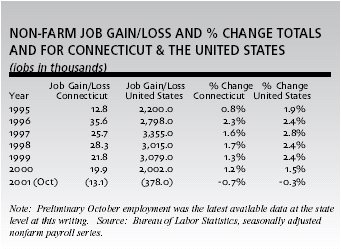
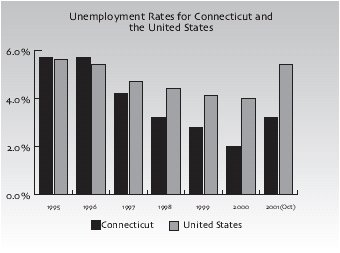
- Labor surplus areas, as designated by the federal government, have average
unemployment rates that are at least 20 percent higher than the average
unemployment rate for all states. Through September 2001, Connecticut had four
towns designated labor surplus areas: Bridgeport, Hartford, Killingly, and
Voluntown. This is down from 21 towns in 1997 and 1998.
- According to the Connecticut Department of Labor, in 2000 the state had
109,000 workers holding more than one job. This represents 6.5 percent of
employed state residents and is up from 5.9 percent in 1999. Nationally, the
number of multiple jobholders declined between 1999 and 2000 from 5.8 percent
to 5.6 percent.
- Over the past 10 years there has been a dramatic change in the industries
in which Connecticut workers are employed. Manufacturing has been and
continues to be in decline. Manufacturing has slipped from employing 20.7
percent of state workers in 1991 to 15 percent in 2001. During the same
period, jobs in the service industry grew from 27 percent to 32 percent of
total employment. While the service industry does include some low skill, low
pay occupations it also includes engineering and management services,
technology and advance business services, health care, and educational services.
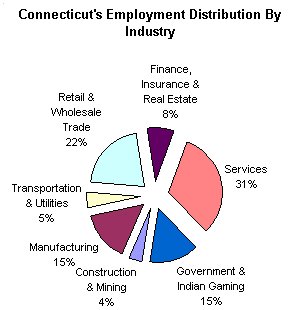
- The Connecticut Labor Department reports that five of the fastest growing
occupations in the state are in the computer technology field. Other fast
growing occupations include: social/human services assistant, medical
assistant, biological scientist, paralegal, and financial sales. Slow growth
is reported in jobs relating to textiles, printing, and machine operations.
Income
- Connecticut leads the nation in per capita income at $40,870 for 2000.
Connecticut's per capita income is 38.8 percent higher than that of the
nation. It should be noted that per capita and total personal income figures
as reported by the Bureau of Economic Analysis do not include income from
capital gains.
Per Capita Personal Income
for Connecticut and the United States
and
Connecticut's Comparative
Advantage
|
Year |
Connecticut |
United States |
% Above The
United States |
|
1995 |
$31,423 |
$23,272 |
35.0% |
|
1996 |
$32,814 |
$24,286 |
35.1% |
|
1997 |
$34,803 |
$25,427 |
36.9% |
|
1998 |
$37,190 |
$26,909 |
38.2% |
|
1999 |
$38,506 |
$27,859 |
38.2% |
|
2000 |
$40,870 |
$29,451 |
38.8% |
|
|
|
|
|
|
SOURCE: Bureau of Economic Analysis, 10/19/01 release |
- Like the nation, Connecticut has experienced strong personal income growth
since 1995. The average annual growth rate from 1995 through 2000 was 5.7
percent in Connecticut and 5.9 percent for the United States.
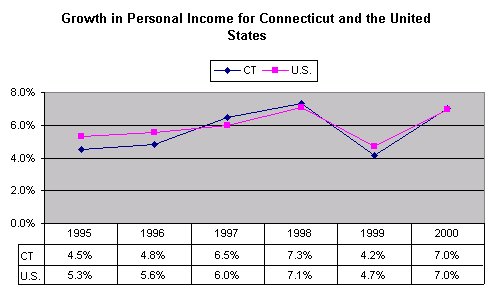
- Personal income is a good indicator of the increase in total state wealth,
but it tells little about how that wealth is distributed among Connecticut's
residents. That is, a state could have every dollar of wealth held in a few
hands and still lead the nation in per capita income. Median income provides a
somewhat better measure of wealth for the average state family.
- Connecticut has the fourth highest real (inflation adjusted) median
household income in the country, ranking behind Maryland, Alaska, and New
Jersey.
- To analyze changes in median income the Census Bureau recommends using a
two- year moving average to smooth any fluctuations caused by sampling errors.
For the 1999-2000 period real median household income in Connecticut was
$51,423, which is 22 percent above the national figure.
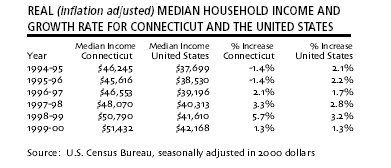
- Through the early and mid 1990's, real median household income in the state
was in decline. This trend was reversed in 1996-97, and since that time the
state has seen real median income growth.
- According to the Connecticut Department of Labor, the ten highest paying
occupations in the state are as follows: physician; dentist; chiropractor; law
teachers; judges and magistrates; financial sales agents; optometrists;
lawyers; engineering; information technology and science managers; and
podiatrists.
- Despite Connecticut's high overall income level; areas of regional poverty
remain a problem. Hartford and New Haven counties have traditionally posted
poverty rates that are approximately 20 percent higher than the state average.
The Census Bureau has reported the state's three-year average poverty rate for
1998-2000 at 7.6 percent. The national average was 11.9 percent.
Other Economic Measures
- According to statistics from the Connecticut Department of Revenue
Services, over the past five fiscal years retail trade sales in the state have
increased at an average annual rate of 6.1 percent. Durable goods expanded at
a 7.1 percent rate, while non-durable goods grew 5.5 percent.
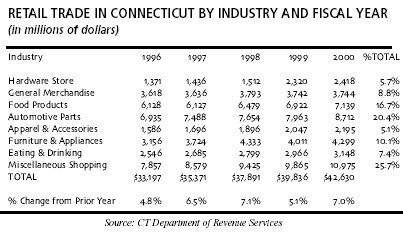
- Based on sales tax receipts for the current year, it is clear that the
recession is having a major impact on retail sales in the state. After three
years of average annualized growth of 4.1 percent in the sales tax, current
projections show virtually no growth for Fiscal Year 2002.
- Connecticut's export sector is playing an important role in the state's
economy. From 1995 through 2000, the state's export of goods grew at an
average annual rate of 5.9 percent. Transportation is the largest single
export component comprising 38.1 percent of exports in 2000.
- The Census Bureau reports that Connecticut's housing stock has increased
4.9 percent between 1990 and 2000. During this same period, population grew
3.6 percent. The state has 1,385,975 housing units. Owner occupied housing
comprises 66.8 percent of the total and the occupancy rate is 93.9 percent.
According to the National Realtors Association, on average Connecticut
families had 138 percent of the income required to buy an averaged priced
single family home. This is 8 percent higher than the national average. The
data suggest that housing in Connecticut is still a good long-term investment.
Table
of Contents | Index of Comptroller's
Reports | Comptroller's Home
Page
![]()